Technical Assistance Supports Microgrids in Remote Communities
Through the Community Microgrid Assistance Partnership, NREL Will Support Advanced Microgrid Development and Optimization in Isolated Areas
Hughes, Alaska, is in the land of the midnight sun. In midsummer, Hughes sees 24-hour daylight as the sun circles the sky without setting.
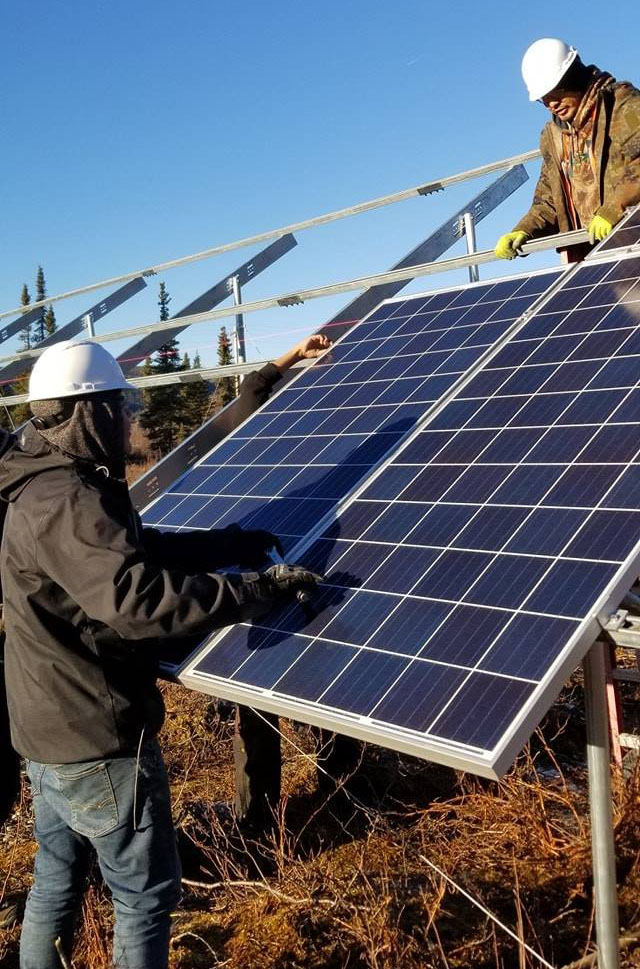
Technicians install solar PV in Hughes, Alaska. Photo from the U.S. Department of Energy
This Koyukon Athabascan village is harvesting sunlight for electricity via a solar photovoltaic (PV) array and battery system, backed by diesel generators, to power their community microgrid.
In the summer of 2023, an unfamiliar sound spread through the village: silence.
The diesel generators switched off, quieting the drone of machines.
The Hughes power system relies on a mix of energy sources, which work in harmony thanks to the microgrid controls. The village has cut its fuel costs in an important demonstration of how renewables can help reduce energy burden in remote areas.
To empower more transformative microgrid development in rural, remote, and underserved areas, the U.S. Department of Energy (DOE) launched the Community Microgrid Assistance Partnership (C-MAP) in October 2024. C-MAP provides easy-to-access funding to plan or improve microgrid systems and offers wraparound services to help participants succeed. DOE's Office of Electricity opened this funding opportunity in a pilot focused on historically disadvantaged and electrically isolated communities in Alaska and Hawaii, as well as Indigenous nations (primarily in the Great Plains and the Southwest). The request for proposals is posted on sam.gov. The solicitation closes on Jan. 31, 2025.
Microgrids Boost Energy Security in Remote Areas
What Is a Microgrid?
Advanced microgrids enable balancing energy supply and demand locally within defined boundaries even when the larger grid experiences interruptions. They are a vital solution for remote areas with no connection to the grid. The technical definition of "microgrid" used by the Office of Electricity is: a group of interconnected loads and distributed energy resources that act as a single controllable entity.
Although many remote power systems operate with just diesel generators, technology innovations and the rapid decrease in the cost of renewable energy and energy storage technologies can increase the operational efficiency of these systems. As demand continues to rise, DOE anticipates advanced microgrids playing a larger role in the national energy system.
The partnership concept was proposed by National Renewable Energy Laboratory (NREL) Senior Engineer Ian Baring-Gould, who has worked for two decades in renewable energy deployment in off-grid communities around the world.
"I grew up in Alaska and started working on microgrids in the late 1980s," Baring-Gould said. "Diesel-powered generators have provided reliable electricity to remote communities in Alaska for generations. A few communities have incorporated renewable energy, reducing the dependence on imported fuels and in some cases allowing the diesel engines to be turned off. Although these advanced microgrids have been in use for more than 20 years, there are still many communities around the globe that import fuel to supply electricity. This tells us that it is not simple to replicate successful innovation from one community to the next and that there is an opportunity for better knowledge sharing."
Diesel-powered microgrids remain the most common mode of supplying energy to isolated communities. Fuel imports depend on long and tenuous supply chains. Energy reliability and resilience are below modern national standards. Modern microgrid designs and controls offer solutions for energy independence and mitigating power disruptions.
In describing the program goals, DOE Under Secretary for Science and Innovation Geri Richmond said, "Remote communities are well positioned to demonstrate optimized microgrid technologies, including those that generate renewable energy locally. With the right design and innovation, microgrid solutions will help lower energy costs, improve energy resilience, and spur economic opportunities."
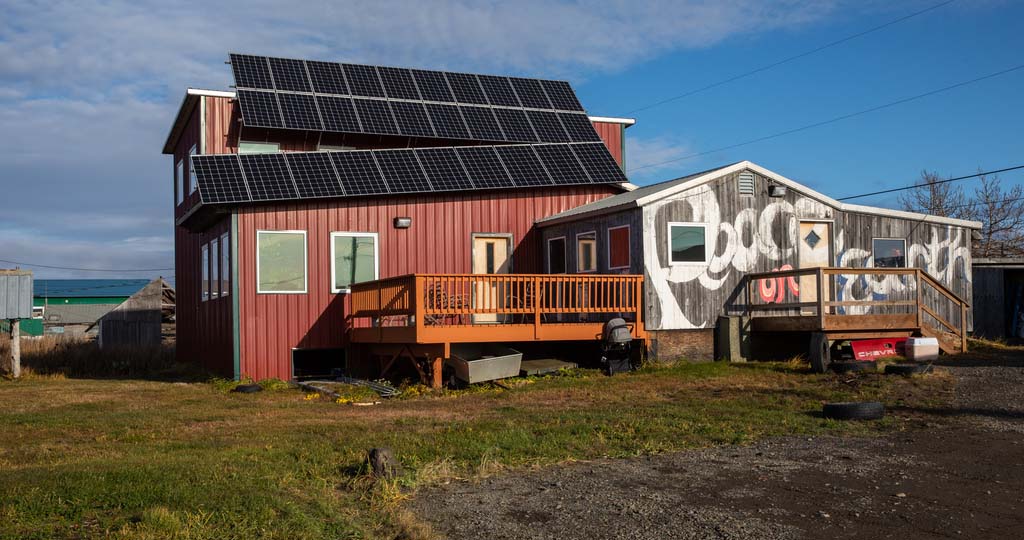
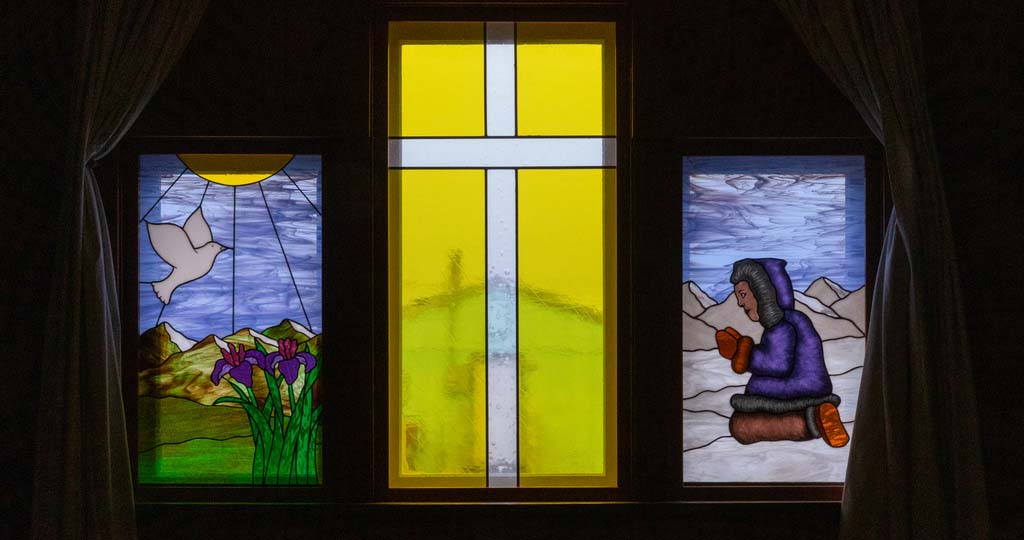
Left: Rooftop solar PV powers a restaurant in Unalakleet, Alaska, a village on the Bering Sea. Right: Sunlight is depicted in artwork at the village church. Photos by Werner Slocum, NREL
Community-Driven Decision-Making
Esghallghilnguq, nagaqullghilnguq, nanghiillghilnguq, nalluksaghqaq. This translates from Yupik as, "What you do not see, do not hear, do not experience, you will never really know."
Engineers from outside the community will always be limited by their distance from the geography, culture, and history of a place. Proposals submitted to C-MAP must be shaped by community leaders and include ongoing community input to ensure the development plan reflects their needs and priorities.
Wraparound services from community-based organizations will support participants in defining the tactics to meet their goals and sustaining their microgrid operations. These technical assistance providers are a critical piece of the partnership given their familiarity with the area and cultural literacy. For example, professor Mariko Shirazi contributes to C-MAP through the Alaska Center for Energy and Power (ACEP) at the University of Alaska Fairbanks. When she explains power inverters to project partners from villages, she compares the two different inverter control modes (grid forming and grid following) to the two different ways to harness a dog team to a sled (fan hitch or gangline hitch).
C-MAP partner organizations thus far include ACEP, Renewable Energy Alaska Project, the Arctic Energy Ambassadors program, the DOE Arctic Energy Office, DeerStone Consulting, Beyond Alaska, the Alliance for Tribal Clean Energy, the DOE Office of Indian Energy Policy and Programs, the Hawaii State Energy Office, and the Hawaii Natural Energy Institute.
"Government programs, like the C-MAP, are meant to improve the quality of lives," said Dan Ton, who manages the Microgrids R&D Program at the DOE Office of Electricity (OE). "We can make a real, impactful difference by working in underserved and Indigenous communities to advance ... OE's mission of bringing the benefits of grid modernization to all Americans."
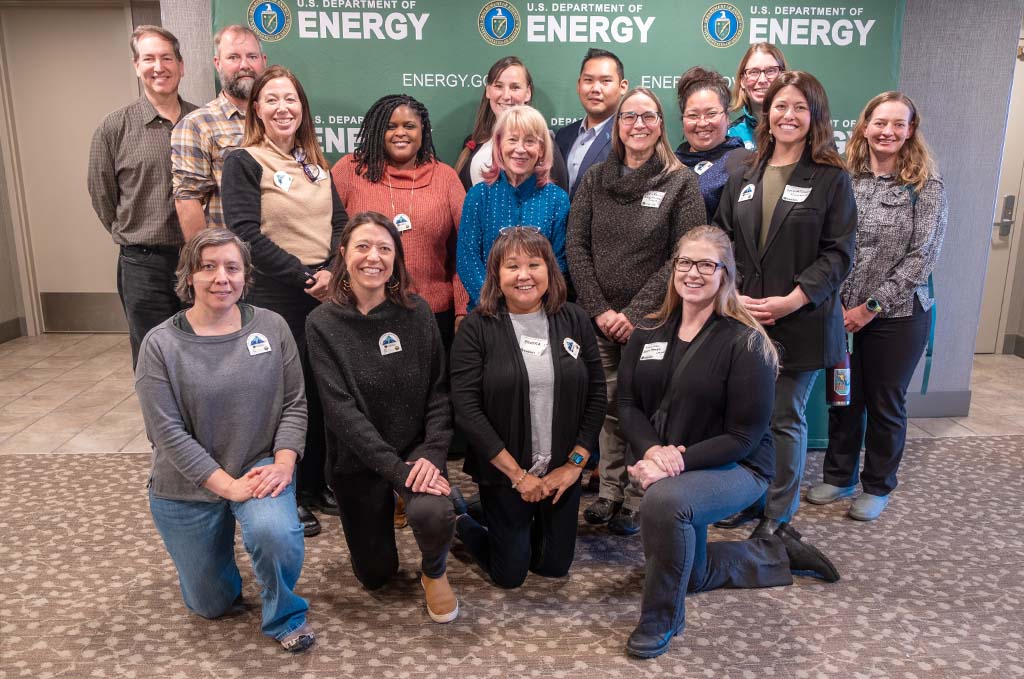
DOE Under Secretary for Science and Innovation Geri Richmond (center) meets with the Arctic Energy Ambassadors and DOE staff during the Alaska Rural Energy Conference in October 2024. Photo by Adam Kane, Alaska Municipal League
Apply for Microgrid Development Assistance and Funding
The streamlined request for proposals was designed to minimize paperwork for communities and include applicants at various stages of microgrid development. For example, C-MAP can support an initial assessment and scope microgrid design or optimize operations of an existing microgrid—whether through a technology innovation or workforce development.
The deadline for the request for proposals was extended to Jan. 31, 2025. Find the instructions on the sam.gov opportunity page. Proposals can be submitted by an individual community. Larger awards are available for groups of communities that propose a joint project. Funding to be provided to communities through this solicitation is expected to be about $7.2 million. DOE's Office of Electricity is interested in supporting the C-MAP effort over the long term, including annual rounds of funding and expanding the geographic coverage for eligible communities.
The program leads hosted a webinar on Nov. 11, 2024, to present the request for proposals and answer questions. View a recording of the proposal webinar:
A Forum for Scaling Solutions
Energy-burdened communities can be hesitant to pursue microgrid systems due to the upfront investment and lack of experience with microgrid operations. This reluctance is changing to demand as more community microgrids come online, new tools remove the barriers to using them, and community experience is more widely communicated. The microgrid systems implemented under C-MAP will be tailored to local conditions and goals, yet each one presents validated replicable solutions and lessons applicable to the market at large.
Alaska has more remote microgrids than any state in the country.
"Alaska is no stranger to microgrids, with over 187 standalone power systems currently operating, most of which rely on expensive fossil fuels," said David Karabelnikoff, Alaska program manager for the Alliance for Tribal Clean Energy, a nonprofit supporting C-MAP. "This heavy dependence contributes to some of the highest energy costs in the nation."
The benefits of C-MAP are not restricted to the communities that submit proposals. The partner organizations will develop and distribute resources for scaling microgrid solutions that have been proven to work in remote, rural, and electrically isolated areas and beyond. The wider network of communities building or operating microgrids can participate in C-MAP's webinars, in-person workshops, case studies, or other engagement forums requested by communities.
"This reality creates a unique opportunity to develop projects that reduce these energy burdens by transitioning to innovative clean and renewable energy technologies," said Chéri Smith, president and CEO of the Alliance for Tribal Clean Energy. "By doing so, we can lower the cost of living for Alaska Native communities and position them as leaders in the transition to a sustainable energy future."
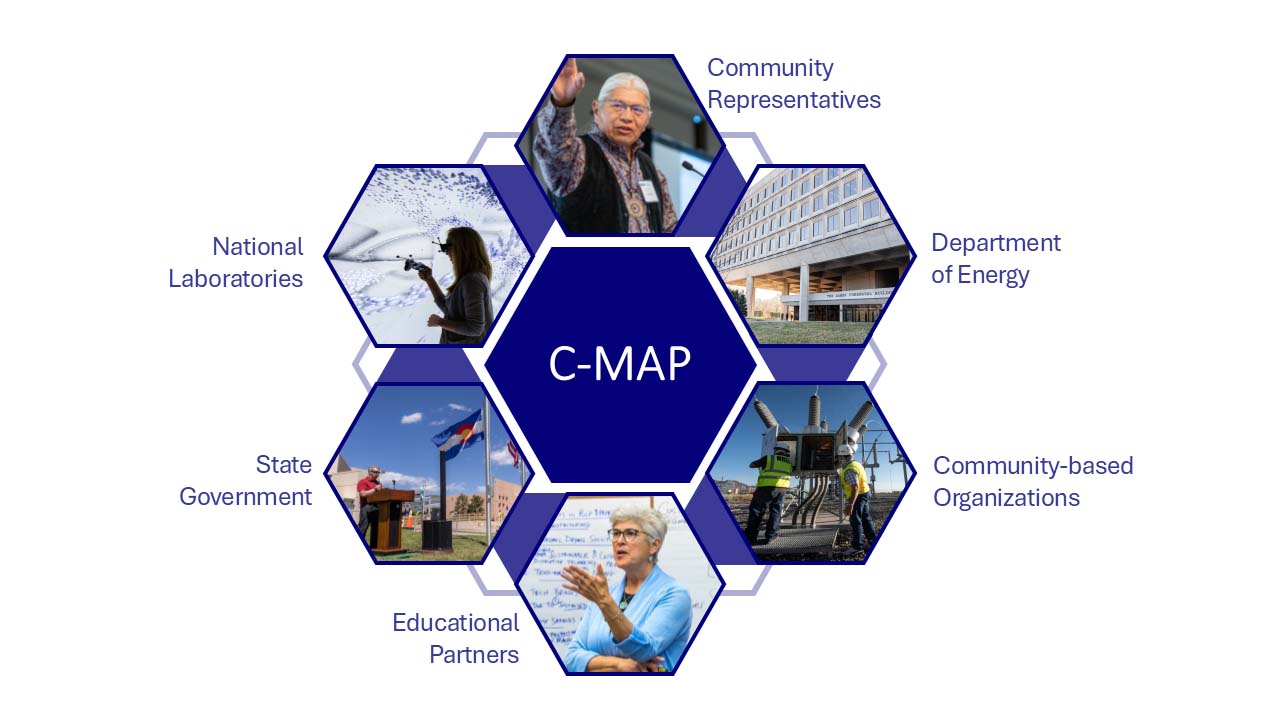
The Community Microgrid Assistance Partnership brings together the actors needed to smooth the path to deployment for microgrid power systems. Graphic by NREL
NREL Facilitates C-MAP's First Workshop in Alaska
The first C-MAP workshop took place at the Alaska Rural Energy Conference in Fairbanks in October 2024 where the request for proposals was announced.
In his opening remarks, Baring-Gould stated, "A real partnership isn't one person telling another what to do. Our goal is to learn and to scale. The feedback from each community will be used to tweak models, develop standards, and improve the way the systems work for all."
Workshop participants voiced several questions C-MAP could address: Are the distribution transformers in community-based microgrids sufficiently robust to manage increased electrification? How can they integrate advanced controls and better data monitoring? What is the plan for recycling or removing assets once they are retired?
The organizations, universities, and laboratories in C-MAP have been investigating these questions and other challenges in the pursuit of making microgrid technology more accessible and efficient. NREL has been involved in the modeling, development, testing, and deployment of microgrids since 2001. This deep research and development experience will be a strong foundation for C-MAP as NREL coordinates activities across the partnership and serves as the technical lead.
Historically used in disaster response or military installations, microgrids are starting to play a larger role in energy markets. For example, NREL supports technical assistance programs including Clean Energy to Communities and the Energy Transitions Initiative Partnership Project led by DOE's Office of Energy Efficiency and Renewable Energy. Nearly all the communities in these programs express an interest in learning more about microgrids.
As microgrid systems become more common in communities, research from C-MAP will be important for reducing barriers to adoption and standardizing components. This gives communities more options for accessing clean and resilient power, no matter where we live.
Learn more about this program at the Community Microgrid Assistance Partnership website. Explore NREL's microgrid research for leading-edge innovation or to partner with NREL to answer your microgrid questions.
This article has been updated to reflect an editorial change made after its original publication.
Last Updated May 28, 2025
